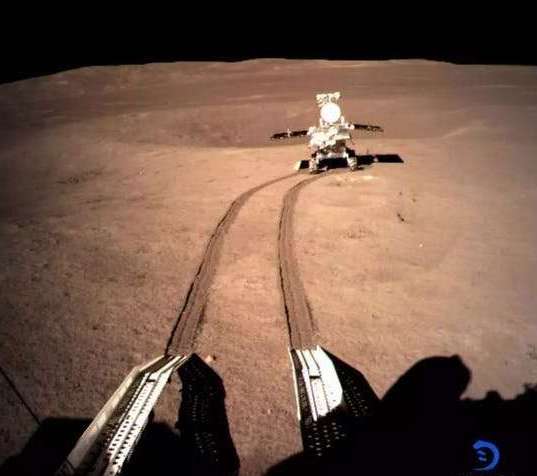

Raw Change’-4 image, showing the Yutu 2 rover, on the moon’s far side. Image via CNSA/HANDOUT/EPA/Phys.org. Read more about this image.
Help EarthSky keep going! Please donate what you can to our annual crowd-funding campaign.
The International Astronomical Union (IAU) said on February 15, 2019, that it has named five sites on the far side of the moon, including the landing site on January 3 of this year of China’s Chang’e-4. The IAU Working Group for Planetary System Nomenclature approved the name Statio Tianhe for the landing site where the Chinese spacecraft touched down. It was the first-ever landing on the far side of the moon.
All five of the new names have significance in Chinese culture, the IAU said.
The name Tianhe originates from the ancient Chinese name for the Milky Way. An old folk tale, known throughout Asia, held that the Milky Way was a Celestial River, separating two lovers (sometimes described as The Cowherd and the Weaver Girl). There are many variations of this legend. In China, it speaks of a forbidden romance between the goddess Zhinu or Zhinyu – often said to be represented by the star Vega in the constellation Lyra – and a humble farm boy, Niulang – represented by the star Altair in the constellation Aquila. Separated in the night sky by the Milky Way, or Celestial River, the two lovers are allowed to meet only once a year. It’s said that meeting comes on the seventh night of the seventh moon, when a bridge of magpies forms across the Celestial River, and the two lovers are reunited. Even today, the Qixi Festival – held in the summertime – marks the time of the lovers’ reunion. Read more about the Qixi Festival and this legend.

Star-crossed lovers Zhinu – represented by the star Vega in the constellation Lyra – and a humble farm boy, Niulang, represented by the star Altair in Aquila. Image via The NewsTalkers.
The IAU said:
Four other names for features near the landing site have also been approved. In keeping with the theme of the above-mentioned folk tale, three small craters that form a triangle around the landing site have been named Zhinyu, Hegu, and Tianjin, which correspond to characters in the tale. They are also names of ancient Chinese constellations from the time of the Han dynasty.
The fifth approved name is Mons Tai, assigned to the central peak of the crater Von Kármán, in which the landing occurred. Mons Tai is named for Mount Tai, a mountain in Shandong, China, and is about 29 miles (46 km) to the northwest of the Chang’e-4 landing site.
Bottom line: The International Astronomical Union (IAU) has named the landing site of the Chinese spacecraft Chang’e-4 – first earthly spacecraft to land on the moon’s far side – plus four other features on the lunar far side.
from EarthSky https://ift.tt/2TczVRZ


Raw Change’-4 image, showing the Yutu 2 rover, on the moon’s far side. Image via CNSA/HANDOUT/EPA/Phys.org. Read more about this image.
Help EarthSky keep going! Please donate what you can to our annual crowd-funding campaign.
The International Astronomical Union (IAU) said on February 15, 2019, that it has named five sites on the far side of the moon, including the landing site on January 3 of this year of China’s Chang’e-4. The IAU Working Group for Planetary System Nomenclature approved the name Statio Tianhe for the landing site where the Chinese spacecraft touched down. It was the first-ever landing on the far side of the moon.
All five of the new names have significance in Chinese culture, the IAU said.
The name Tianhe originates from the ancient Chinese name for the Milky Way. An old folk tale, known throughout Asia, held that the Milky Way was a Celestial River, separating two lovers (sometimes described as The Cowherd and the Weaver Girl). There are many variations of this legend. In China, it speaks of a forbidden romance between the goddess Zhinu or Zhinyu – often said to be represented by the star Vega in the constellation Lyra – and a humble farm boy, Niulang – represented by the star Altair in the constellation Aquila. Separated in the night sky by the Milky Way, or Celestial River, the two lovers are allowed to meet only once a year. It’s said that meeting comes on the seventh night of the seventh moon, when a bridge of magpies forms across the Celestial River, and the two lovers are reunited. Even today, the Qixi Festival – held in the summertime – marks the time of the lovers’ reunion. Read more about the Qixi Festival and this legend.

Star-crossed lovers Zhinu – represented by the star Vega in the constellation Lyra – and a humble farm boy, Niulang, represented by the star Altair in Aquila. Image via The NewsTalkers.
The IAU said:
Four other names for features near the landing site have also been approved. In keeping with the theme of the above-mentioned folk tale, three small craters that form a triangle around the landing site have been named Zhinyu, Hegu, and Tianjin, which correspond to characters in the tale. They are also names of ancient Chinese constellations from the time of the Han dynasty.
The fifth approved name is Mons Tai, assigned to the central peak of the crater Von Kármán, in which the landing occurred. Mons Tai is named for Mount Tai, a mountain in Shandong, China, and is about 29 miles (46 km) to the northwest of the Chang’e-4 landing site.
Bottom line: The International Astronomical Union (IAU) has named the landing site of the Chinese spacecraft Chang’e-4 – first earthly spacecraft to land on the moon’s far side – plus four other features on the lunar far side.
from EarthSky https://ift.tt/2TczVRZ

Aucun commentaire:
Enregistrer un commentaire